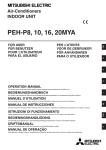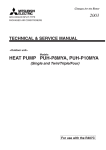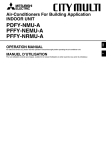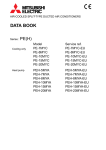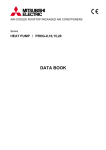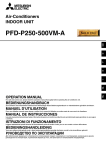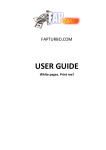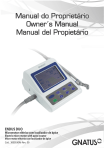Download Mitsubishi Electric PRH-P8MYA Specifications
Transcript
Air-Conditioners ROOFTOP UNIT D PER L’UTENTE VOOR DE GEBRUIKER FÖR ANVÄNDAREN PARA O UTILIZADOR E F FOR USER FÜR BENUTZER POUR L’UTILISATEUR PARA EL USUARIO GB PRH-P8, 10, 16, 20MYA BEDIENUNGSHANDBUCH Zum sicheren und einwandfreien Gebrauch der Klimaanlage dieses Bedienungshandbuch vor Inbetriebnahme gründlich I OPERATION MANUAL For safe and correct use, please read this operation manual thoroughly before operating the air-conditioner unit. durchlesen. Pour une utilisation correcte sans risques, veuillez lire le manuel d’utilisation en entier avant de vous servir du climatiseur. MANUAL DE INSTRUCCIONES NL MANUEL D’UTILISATION ISTRUZIONI DI FUNZIONAMENTO Leggere attentamente questi istruzioni di funzionamento prima di avviare l’unità, per un uso corretto e sicuro della stessa. SW Lea este manual de instrucciones hasta el final antes de poner en marcha la unidad de aire acondicionado para garantizar un uso seguro y correcto. DRIFTSMANUAL Läs denna driftsmanual noga för säkert och korrekt bruk innan luftkonditioneringen används. MANUAL DE OPERAÇÃO Para segurança e utilização correctas, leia atentamente o manual de operação antes de pôr a funcionar a unidade de ar condicionado. P BEDIENINGSHANDLEIDING Voor een veilig en juist gebruik moet u deze bedieningshandleiding grondig doorlezen voordat u de airconditioner gebruikt. 2 [Fig. 2.0.1] <A> <B> D D C C B C B C E E A A E E GB PRH-P8, 10MYA <A> <B> D D D D C D C C C F B NL E B E C C A A E E PRH-P16, 20MYA I SW <A> In case of side flow <B> In case of top flow A Return air B Supply air C Outdoor heat exchanger air inlet D Outdoor heat exchanger air outlet E Fresh air intake E [Fig. 2.0.2] A ON/OFF P TEMP. A Remote controller 2 Contents 1. Safety precautions ...................................................................................... 1.1. Installation ................................................................................. 1.2. During operation ........................................................................ 1.3. Disposing of the unit .................................................................. 2. Names and functions of various parts ........................................................ 3. Operation .................................................................................................... 3.1. ON/OFF ..................................................................................... 3.2. Selecting operation .................................................................... 3.3. Room temperature adjustment .................................................. 3 3 3 4 4 4 5 5 6 4. 5. 6. 7. 8. 3.4. Fan speed adjustment ............................................................... 3.5. Time setting ............................................................................... 3.6. Timer setting .............................................................................. 3.7. Others ........................................................................................ The smart way to use ................................................................................. Caring for the machine ............................................................................... Troubleshooting ........................................................................................... Installation and transferring works, and checking ....................................... Specifications .............................................................................................. 6 6 6 7 7 7 7 8 9 1. Safety precautions Warning: The remote controller should be installed in such a way that children cannot play with it. 3) Drain hose : Indicates that important instructions must be followed. : Indicates a part which must be grounded. • • : Indicates that caution should be taken with rotating parts. (This symbol is displayed on the main unit label.) <Color: yellow> : Beware of electric shock. (This symbol is displayed on the main unit label.) <Color: yellow> Warning: Carefully read the labels affixed to the main unit. 1.1. Installation Warning: • • • • • • The unit should not be installed by the user. Ask the dealer or an authorized company to install the unit. If the unit is installed improperly, water leakage, electric shock or fire may result. Use only accessories authorized by Mitsubishi Electric and ask your dealer or an authorized company to install them. If accessories are installed improperly, water leakage, electric shock or fire may result. The Installation Manual details the suggested installation method. Any structural alteration necessary for installation must comply with local building code requirements. Never repair the unit or transfer it to another site by yourself. If repair is performed improperly, water leakage, electric shock or fire may result. If you need to have the unit repaired or moved, consult your dealer. The appliance is not intended for use by young children or infirm persons without supervision. Young children should be supervised to ensure that they do not play with the appliance. 1) Unit Caution: • • Warning: • • • • • • • • • • • The unit must be installed on a stable, level surface, in a place where there is no accumulation of snow, leaves or rubbish. Do not stand on, or place any items on the unit. You may fall down or the item may fall, causing injury. The unit should be securely installed. If the unit is loosely mounted, it may fall, causing injury. Caution: The unit should be installed in a location where air and noise emitted by the unit will not disturb the neighbours. The unit must be properly grounded. Never connect the grounding wire to a gas pipe, water pipe, lightning conductor or telephone grounding wire. If the unit is not grounded properly, electric shock may result. Check frequently that the ground wire from the unit is properly connected to both the unit’s ground terminal and the grounding electrode. 1.2. During operation Warning: • Make sure that the unit is powered by a dedicated line. Other appliances connected to the same line could cause an overload. Make sure that there is a main power switch. Be sure to adhere to the unit’s voltage and fuse or circuit breaker ratings. Never use a piece of wire or a fuse with a higher rating than the one specified. 5) Grounding s After you have read this manual, keep it and the Installation Manual in a safe place for easy reference whenever a question arises. If the unit is going to be operated by another person, make sure that this manual is given to him or her. D Warning: • F : Indicates an action that must be avoided. 4) Power line, fuse or circuit breaker NL Symbols used in the illustrations Do not splash water over the unit and do not touch the unit with wet hands. An electric shock may result. Do not spray combustible gas close to the unit. Fire may result. Do not place a gas heater or any other open-flame appliance where it will be exposed to the air discharged from the unit. Incomplete combustion may result. Do not remove the front panel or the fan guard from the unit when it is running. You could be injured if you touch rotating, hot or high-voltage parts. Never insert fingers, sticks etc. into the intakes or outlets, otherwise injury may result, since the fan inside the unit rotates at high speed. Exercise particular care when children are present. If you detect odd smells, stop using the unit, turn off the power switch and consult your dealer. Otherwise, a breakdown, electric shock or fire may result. When you notice exceptionally abnormal noise or vibration, stop operation, turn off the power switch, and contact your dealer. Do not over-cool. The most suitable inside temperature is one that is within 5°C of the outside temperature. Do not leave handicapped people or infants sitting or standing in the path of the airflow from the air-conditioner. This could cause health problems. Caution: • • • Do not use any sharp object to push the buttons, as this may damage the remote controller. Do not twist or tug on the remote controller cord as this may damage the remote controller and cause malfunction. Never remove the upper case of the remote controller. It is dangerous to remove the upper case of the remote controller and touch the printed circuit boards inside. Doing so can result in fire and failure. 3 SW Caution: Describes precautions that should be observed to prevent damage to the unit. Caution: Make sure that the drain hose is installed so that drainage can go ahead smoothly. Incorrect installation may result in water leakage, causing damage to furniture. I Describes precautions that should be observed to avoid the risk of injury or death to the user. GB Warning: E Symbols used in the text 2) Remote controller P s Before operating the unit, make sure you read all the “Safety precautions”. s “Safety precautions” lists important points about safety. Please be sure to follow them. • • • • Never wipe the remote controller with benzene, thinner, chemical rags, etc. Doing so can result in discoloration and failure. To remove heavy stains, soak a cloth in neutral detergent mixed with water, wring it out thoroughly, wipe the stains off, and wipe again with a dry cloth. Never block or cover the unit’s intakes or outlets. Tall items of furniture underneath the indoor air inlet and outlet part, or bulky items such as large boxes placed close to the unit will reduce the unit’s efficiency. Do not direct the airflow at plants or caged pets. Ventilate the room frequently. If the unit is operated continuously in a closed room for a long period of time, the air will become stale. In case of failure When the air conditioner is not to be used for a long time • • • Warning: • • • GB • Never remodel the air conditioner. Consult your dealer for any repair service. Improper repair work can result in water leakage, electric shock, fire, etc. If the remote controller displays an error indication, the air conditioner does not run, or there is any abnormality, stop operation and contact your dealer. Leaving the unit as it is under such conditions can result in fire or failure. If the power breaker is frequently activated, get in touch with your dealer. Leaving it as it is can result in fire or failure. If the refrigeration gas blows out or leaks, stop the operation of the air conditioner, thoroughly ventilate the room, and contact your dealer. Leaving the unit as it is can result in accidents due to oxygen deficiency. If the air conditioner is not to be used for a long time due to a seasonal change, etc., run it for 4 - 5 hours with the air blowing until the inside is completely dry. Failing to do so can result in the growth of unhygienic, unhealthy mold in scattered areas throughout the room. When it is not to be used for an extended time, keep the [power supply] turned OFF. If the power supply is kept on, several watts or several tens of watts will be wasted. Also, the accumulation of dust, etc., can result in fire. Keep the power switched ON for more than 12 hours before starting operation. Do not turn the power supply OFF during seasons of heavy use. Doing so can result in failure. 1.3. Disposing of the unit Warning: When you need to dispose of the unit, consult your dealer. If pipes are removed incorrectly, refrigerant (fluorocarbon gas) may blow out and come into contact with your skin, causing injury. Releasing refrigerant into the atmosphere also damages the environment. D 2. Names and functions of various parts Unit Remote Controller PRH-P-MYA series [Rooftop type] • [Fig. 2.0.1] (P.2) F <A> In case of side flow Check out your remote controller. Different controllers are used for different systems. [Fig. 2.0.2] (P.2) <B> In case of top flow A Return air C Outdoor heat exchanger air inlet D Outdoor heat exchanger air outlet B Supply air E Fresh air intake A Remote controller NL 3. Operation Cooling Automatic (cooling / heating) • The air conditioner works to cool the room to the selected temperature. • Even if the room temperature reaches the target temperature and the compressor comes to a stop, the fan will keep running at full speed. The air conditioner automatically goes into the cooling or heating mode to keep the room at the selected temperature. • The air conditioner works to heat the room to the selected temperature. • When selecting the heating mode, a desired room temperature must be set to avoid any cool air. The fan will gradually increase the airflow delivery up to a selected rate. • Even if the room temperature reaches the target temperature and the compressor comes to a stop, the fan will keep running at full speed. The fan can be stopped by setting the switch to OFF. P E I SW Heating 4 Ventilation • Ventilation will not be displayed when not available (settings cannot be specified). • When ventilation is selected it will operate in all modes. Note: The airflow settings cannot be changed on the main unit. D C B 1Hr. CENTRALLY CONTROLLED ON OFF ˚C CLOCK CHECK FILTER CHECK MODE TEST RUN FUNCTION ˚C STAND BY DEFROST ERROR CODE 1 A U T Q S NOT AVAILABLE R ON/OFF B 2 1Hr. CENTRALLY CONTROLLED ON TEMP. FILTER 3 A 0 CHECK TEST E OFF CHECK FILTER CHECK MODE TEST RUN FUNCTION ˚C F P O ˚C CLOCK STAND BY DEFROST ERROR CODE NOT AVAILABLE TEMP. N M ON/OFF TIMER SET PAR-20MAA C G H I KL J 4 5 6 87 9 Remote controller-Button • 7 [Up/down airflow direction] Button A Current time/Timer K Not available function 2 [Timer/continuous] Button 8 [Ventilation] Button B Centralized control L Ventilation 3 [Selecting operation] Button 9 [Checking/built-in] Button C Timer ON M Function setting mode 4 [Time selection] Button 0 [Test run] Button D Abnormality occurs N Test run mode [Time-setting] Button A [Filter] Button E O Error check mode 5 [Louver] Button B [ON/OFF] Button COOL, Operation mode: AUTO, FAN, HEAT P Filter sign 6 [Fan speed adjustment] Button C Position of built-in room temperature F Preparing for Heating mode Q Set effective for 1 hr. G Defrost mode R Sensor position H Set temperature S Room temperature I Power ON T Airflow J Louver U Fan speed Never expose the remote controller to direct sunlight. Doing so can result in the erroneous measurement of room temperature. Never place any obstacle around the lower right-hand section of the remote controller. Doing so can result in the erroneous measurement of room temperature. GB [Room temperature adjustment] Button D • Remote controller-Display 1 A When selecting operation FILTER CHECK MODE TEST RUN FUNCTION ˚C STAND BY DEFROST ERROR CODE NOT AVAILABLE TEMP. A ON/OFF B 1 FILTER 3 CHECK TEST 2 PAR-20MAA For cooling Press the 3 [selecting operation] button and bring up the “ 6 87 Before starting operation • Start running after the “HO” display has disappeared. The “HO” display briefly appears on the room temperature display (max. 3 minutes) when the power is turned on and after a power failure. This does not indicate any failure of the air conditioner. • During heating operation, even if the indoor unit is set to operation while the outdoor unit is in defrosting operation, operation starts after the defrosting operation of the outdoor unit has ended. • The fan operation functions to circulate the air in the room. • The temperature of the room cannot be set by fan operation. Caution: For heating Press the 3 [selecting operation] button to bring up the “ Regarding displays during heating operation “DEFROST” Displayed only during the defrosting operation. Caution: • Stop an operation 1. Press the B [ON/OFF] button again Operation lamp goes off and operation stops. • Once the buttons have been set, pressing of the [ON/OFF] button only can repeat the same operation thereafter. • During operation, the operation lamp above the [ON/OFF] button lights up. Caution: Even if the operation button is pressed immediately after the operation is once stopped, operation is not restarted for about 3 minutes. This function protects the machine. It automatically starts operation after the lapse of approximately 3 minutes. ” display. “STAND BY” Displayed from the start of heating operation until the moment warm air blows out. 3.1. ON/OFF 1. Press the B [ON/OFF] button Operation lamp lights up and operation starts. ” display. Never expose your body directly to cool air for a long time. Excessive exposure to cool air is bad for your health, and should therefore be avoided. • Start an operation ” display. For fan Press the 3 [selecting operation] button and bring up the “ TIMER SET 4 1. Press the 3 [selecting operation] button Consecutive press of the selecting operation button switches the operation over to E “ ”, “ ”, (“ ”), and (“ ”). For the contents of operation, check the display. NL ˚C SW E 1Hr. OFF I ON CLOCK When the air conditioner is used together with burners, thoroughly ventilate the area. Insufficient ventilation can result in accidents due to oxygen deficiency. Never place a burner at a place where it is exposed to the airflow from the air conditioner. Doing so can result in imperfect combustion of the burner. The microcomputer functions in the following cases: • Air does not blow out when heating starts. - To prevent any cool air from escaping. Wait a moment until the airflow comes out naturally. • The air keeps flowing out, even when the operation has been stopped. For Approximately 1 minute after the operation stops, the fan sometimes stays on to eliminate excess heat generated by various parts of the unit such as the electric heater. • Air supply during thermo off can be stopped from the remote controller provided that the remote controller is located within the air-conditioned room and that the suction air temperature detection spot is switched from “unit” to “remote control.” 5 E CENTRALLY CONTROLLED CHECK P C F 3.2. Selecting operation For ventilation Press the operation mode ( tion mode . B ) button and select the ventila- 3.6. Timer setting • If the timer is set, the unit starts (stops) at the set time, and the time mode is terminated. • When you wish to confirm the starting and ending time, press the 4 [time selection] button while C “ ” is displayed. should be displayed. • Used to provide ventilation without using the heat or air conditioning functions of the unit. • The tached. display will not appear when the ventilation equipment is not at- Function of timer On-timer 3.3. Room temperature adjustment Set the on-timer for the time the working day begins in your company. When the set start time arrives, the air conditioner starts operation. To change room temperature Off-timer Press the 1 [room temperature adjustment] button and set the room temperature of your choice. Pressing or once changes the setting by 1 °C. If the pressing is continued, the setting continues to change by 1 °C. Use the off-timer as a reminder to turn off the air conditioner. When the set endwork time arrives, the air conditioner stops operation. • 1. ON/OFF Timer: When setting both starting and ending time Indoor temperature can be set within the following range. GB Cooling: 19 - 30 °C Heating: 17 - 28 °C There are three methods for using the timer. 2. On-timer: When only setting the starting time (Ending time is set to “ - - : - - ”) When only setting the ending time (Starting time is set to “ - - : - - ”) • It is impossible to set the room temperature by the air-blow operation. 3. Off-timer: * The range of room temperature display is 8 - 39 °C. Outside this range, the display flashes either 8 - 39 °C to inform you if the room temperature is lower or higher than the displayed temperature. Display example of timer setting ON OFF 3.4. Fan speed adjustment ON OFF Fan speed : 1 stage (High) D Display : F The example shows a timer set for operation start at 8:00 and end at 17:00. 3.5. Time setting 1. Press the 2 [timer/continuous] button and bring up the C no display • Set the current time after turning ON the power of the air conditioner or after restoration from a power failure. 2. Press the 4 [time selection] button and bring up the A “Timer start time” display • It can be set regardless of the operation of the indoor unit. • During the time operation, the time-setting button becomes void, disabling time setting. 3. Press the 4 starting time 1. Press the 4 [time selection] button and bring up the A “current time” display CLOCK “current time” ON “timer start time” NL Every time it is pressed, the display changes. OFF • “timer end time” (no display) ) button of the 4 [time selection] and set the ( When using it as an off-timer, set the starting time to “ - - : - - ”. The “ - - : - - ” is displayed next to 23:50. 4. Press the 4 [time selection] button and bring up the A “Timer end time” display 5. Press the 4 ing time ( ) button of the [time selection] and set the end- When using it as an on-timer, set the ending time to “ - - : - - ”. The “ - - : - - ” is displayed next to 23:50. 6. Press the 2 [timer/continuous] button and bring up the C “ When the current time is not yet set, the “CLOCK (current time)” display flashes, disabling the setting of timer operation. 2. Set the current time by pressing the 4 or button • The time cannot be set while the C “Timer ON” is displayed. • While the A “CLOCK” time is displayed, press the time setting 4 buttons and set the time. • button is pressed The setting advances one minute every time the 4 once, and regresses one minute every time the 4 button is pressed once. When respective 4 / buttons are pressed continuously, the time display forward fast. It advances in the order of 1 minute unit - 10 minute unit one hour unit. I SW Caution: About 10 seconds after the button operation has been completed, the C “Timer ON” and A “CLOCK” displays disappear. E • / Caution: • Release Press the 2 [timer/continuous] button and disappear the “ ” display. 1) Ventilator-Airconditioner combined operation 1. If the unit is off, press the B [ON/OFF] button to turn it on. The ON indicator should light up. • The ventilation equipment will operate automatically when connected to the unit. 2. Press the 8 • button. You can set the ventilation speed at LOW or HIGH. 2) Changing the ventilation setting button. Press the 8 The setting changes each time the button is pushed. [Low] 6 ” display. ” display completes the setting ( ) button of the 4 [time selection] is pressed once, it Every time the 4 advances (or regresses) by 10 minutes. If the button is pressed continuously, it advances (or retrogresses) continuously. First set the hour digit and then set the minute digit. When the ON/OFF timer mode is set, you can run (on-timer) or stop (off-timer) operation by pressing the B [ON/OFF] button even when there is remaining time. • P • Remote controller is equipped with a simplified clock with a precision of about + or - one minute per month. The time must be readjusted (reset) every time the air conditioner is subjected to a power stop of the air conditioner or a power failure. Bringing up the C “ → ← [High] 3.7. Others CENTRALLY CONTROLLED STAND BY DEFROST CHECK NOT AVAILABLE : Displayed when control is executed by a separately sold centralized control unit, etc. : Displayed from the start of heating operation until the moment warm air blows out. : This displays indication when some abnormality occurs in the unit. : When a button is pressed for any function which the indoor unit cannot perform, this display flashes concurrently with the display of that function. FILTER : In the system in which the [Sensor] display is indicated as the “remote controller”, room temperature measurement is performed by the room temperature sensor built into the remote controller. Therefore, pay attention to the following: : Displayed when it is time to clean the filter. Press the A [Filter] button twice, then the display is disappeared. 4. The smart way to use Prevent intrusion of heat during air-cooling • Set the right room temperature • In cooling operation, a temperature difference of about 5°C between indoors and outdoors is optimum. • If the room temperature is raised by 1°C during air-cooling operation, about 10% electric power can be saved. • Excessive cooling is bad for health. It also results in the waste of electric power. Carry out ventilation sometimes • Since the air periodically gets dirty in a room that is kept closed for a long time, ventilation is sometimes necessary. When gas appliances are used together with the air conditioner, special precautions must be taken. If the “LOSSNAY” ventilation unit developed by our company is used, you can perform ventilation with less waste. For details on this unit, consult with your dealer. • Do not dry the filter by exposing it to direct sunlight or warming it using fire, etc. Doing so can result in the deformation of the filter. Washing it in hot water (more than 50 °C) can also result in deformation. Clean the filter thoroughly If the screen of the air filter becomes clogged, the airflow and air-conditioning effect can be significantly reduced. Further, if the condition is left unattended, failure can result. It is particularly important to clean the filter at the beginning of the cooling and heating seasons. (When profuse dust and dirt have accumulated, clean the filter thoroughly.) D • To prevent the intrusion of heat during cooling operation, provide a curtain or a blind on the window to block out direct sunlight. Also, do not open the entrance or exit except in cases of dire necessity. GB Even minimal steps to care for your air conditioner can help make its use far more effective in terms of air-conditioning effect, electricity charges, etc. 5. Caring for the machine Caution: How to clean F Caution: Never pour water or flammable sprays onto the air conditioner. Cleaning using these methods can result in the failure of the air conditioner, electric shock, or fire. SW Clear dust away lightly or clean it up with a vacuum cleaner. In the case of severe staining, wash the filter in lukewarm water mixed with dissolved neutral detergent or water, and then rinse off the detergent completely. After washing, dry it and fix it back into place. 6. Troubleshooting Before you call out a repair man, check the following table to see whether there is a simple solution to your problem. ● Unit does not cool or heat very well. • Clean the filter. (Dust and debris that collects in the filter will decrease airflow.) • Check the temperature setting and adjust it if necessary. • Increase the space surrounding the unit. Is the air intake or air outlet blocked? • Is a window or door open? ● The unit does not blow air out right away in the heating mode. • The unit is preparing to deliver warm air. ● The unit stops operating before arriving at the set temperature in the heating mode. • Frost forms when the outdoor temperature is low and humidity is high. Wait for about 10 minutes for the frost to melt. ● There is a “swishing” noise that occurs from the unit when water flows. • This sound is made when refrigerant inside of the unit is flowing or refilling. ● A ticking noise is heard from inside of the unit. • This sound is made when internal parts of the unit expand or contract when the temperature changes. ● An odor is detected in the room. • This is caused when the unit expels odors that have been absorbed from the walls, carpets, furniture or clothing. ● A white mist is expelled from the air outlet part. • This may occur just after the unit is turned on when a high level of humidity is present in the room. I • • ● Water or moisture is expelled from the unit. • This occurs to expel water or moisture that may have collected in the pipes or around piping fixtures. • This occurs to dispel water from the heat exchanger. ● The indicators of the remote controller do not light up when operated. • Turn on the power switch. “ · ” will be displayed. E • Before you start cleaning, stop operation and turn OFF the power supply. Remember that the fan is rotating inside at high speed, posing a serious risk of injury. Clean the filter installed in the field once a week (more a dusty place). ● CENTRALLY CONTROLLED is displayed in the remote controller. • The start and stop functions of the remote controller are not available when the CENTRALLY CONTROLLED message is lit. ● The start and stop functions are not available just after restarting the unit. • Wait about three minutes (operation has stopped to prevent damage to the air conditioner). 7 P • Caution: NL Always have filter maintenance performed by a service person. Before care-taking, turn the power supply OFF. ● The unit started even though the start/stop button was not pushed. • Is the timer on? Press the start/stop button to stop the unit. • Was a distant command sent from the remote controller? Find out if the remote controller was used. • Is the CENTRALLY CONTROLLED message lit? Find out if the remote controller was used. • Is the automatic (cooling/heating) mode selected? Press the start/stop button to stop the unit. ● The unit stopped even though the start/stop button was not pushed. • Is the timer on? Press the start/stop button to restart the unit. • Was a distant command sent from the remote controller? Find out if the remote controller was used. • Is the CENTRALLY CONTROLLED message lit? Find out if the remote controller was used. ● The remote controller’s timer cannot be set. • Set the schedule timer if one is connected. GB ● “HO” is displayed in the remote controller. • An automatic startup test is being performed (will last for about two minutes). ● The fan in the unit does not operate. • Check the over-current relay on the fan motor to determine whether it has been tripped. If the over-current relay has been tripped, reset it after eliminating the cause of the problem (e.g. motor lock). To reset the over-current relay, open the control box and press the green claw on bottom-right of the relay until a click is heard. Release the claw and check that it returns to its original position. Note that if it is pressed too hard it will not return to its original position. NOTE: The following do not indicate any malfunction: Odours: smells such as tobacco or cosmetic odours may persist after they have been sucked into the unit. Sound of liquid flowing inside air inlet and outlet part: this can occur during or after operation and is simply the sound of refrigerant being circulated inside the unit. Ticking sound coming from air inlet and outlet part: this can occur when cooling or heating has just begun or has just stopped. It is caused by the indoor unit shrinking or expanding slightly due to the change in temperature. The message “CENTRALLY CONTROLLED” appearing on the LCD panel: from time to time, this message may come up on the LCD panel. This does not indicate any malfunction. ● An error code is displayed in the remote controller. • A self-diagnostic function is being performed to preserve the air conditioner. * Do not attempt to make repairs yourself. Turn the main switch off and contact the dealer from whom you bought the air conditioner. Provide him or her with the name of the unit and the information displayed in the remote controller. D 7. Installation and transferring works, and checking Regarding place for installation Consult with your dealer for details on installation and transferring the installation. Regarding transfer of installation • Caution: SW NL F Never install the air conditioner where there is a risk of leakage of flammable gas. If gas leaks and accumulates around the unit, fire can result. Never install the air conditioner at the following place: • where there is much machine oil • near ocean and beach areas where there is much salt • where humidity is high • where there are hot springs nearby • where there is much sulfureted gas • where there is a high-frequency processing machinery (a high-frequency welder, etc.) • where acid solution is frequently used • where special sprays are frequently used • Install the unit horizontally. Otherwise, water leakage can result. • Take sufficient measures against noise when installing the air conditioners at hospitals or communication-related businesses. I If the air conditioner is used in any of the above-mentioned environments, frequent operational failure can be expected. It is advisable to avoid these types of installation sites. For further details, consult with your dealer. Regarding electrical work Caution: E • • P • The electrical work must be undertaken by a person who is qualified as an electric engineer according to the [technical standard respecting electrical installation], [internal wiring rules], and the installation instruction manual with the absolute use of exclusive circuits. The use of other products with the power source can result in burnt-out beakers and fuses. Never connect the grounding wire to a gas pipe, water pipe, arrester, or telephone grounding wire. For details, consult with your dealer. In some types of installation sites, the installation of an earth leakage breaker is mandatory. For details, consult with your dealer. 8 When removing and reinstalling the air conditioner when you enlarge your home, remodel, or move, consult with your dealer in advance to ascertain the cost of the professional engineering work required for transferring the installation. Caution: When moving or reinstalling the air conditioner, consult with your dealer. Defective installation can result in electric shock, fire, etc. Regarding noise • In installing work, choose a place that can fully bear the weight of the air conditioner, and where noise and vibration can be reduced. • Choose a place where cool or warm air and noise from the outdoor air outlet of the air conditioner do not inconvenience the neighbors. • If any alien object is placed near the outdoor air outlet of the air conditioner, decreased performance and increased noise can result. Avoid placing any obstacles adjacent to the air outlet. • If the air conditioner produces any abnormal sound, consult with your dealer. Maintenance and inspection • If the air conditioner is used throughout several seasons, the insides can get dirty, reducing the performance. Depending upon the conditions of usage, foul odors can be generated and drainage can deteriorate due to dust and dirt, etc. 8. Specifications PRH-P-MYA SERIES Model Item Voltage Power source Frequency 3N~ V Hz kW Cooling capacity*1 kcal/h kW Heating capacity*1 kcal/h Height mm Dimension Width mm Depth mm Net weight kg Airflow rate m3/min Indoor fan External static pressure*2 Pa Outdoor fan Airflow rate m3/min Noise level dB(A) PRH-P8MYA 380, 400, 415 50 20.9 18,000 23.7 20,400 1,715 2,000 961 407 70 100 185 59 PRH-P10MYA 380, 400, 415 50 26.0 22,400 30.5 26,200 1,715 2,000 961 412 90 100 185 60 PRH-P16MYA 380, 400, 415 50 41.8 36,000 47.4 40,800 1,735 2,000 2,130 857 140 200 185 × 2 62 PRH-P20MYA 380, 400, 415 50 52.0 44,800 61.0 52,400 1,735 2,000 2,130 872 180 200 185 × 2 63 GB Notes: *1 Refer to the product nameplate attached to the unit for the electrical specifications. *2 Rating conditions (cooling) Indoor: 27°C DB, 19°C WB Outdoor: 35°C DB, 24°C WB *3 Rating conditions (heating) Indoor: 20°C DB Outdoor: 7°C DB, 6°C WB Operating range Heating Maximum Minimum Maximum Minimum Indoor air intake temperature 32°C DB, 24°C WB 21°C DB, 15°C WB 28°C DB 20°C DB Outdoor air intake temperature 43°C DB –5°C DB 24°C DB, 18°C WB –11°C DB, –12°C WB D Cooling P E I SW NL F Units should be installed by licensed electric contractor accordingly to local code requirement. 9 This product is designed and intended for use in the residential, commercial, and light-industrial environment. The product at hand is based on the following EU regulations: • • Low Voltage Directive 73/23/EEC Electromagnetic Compatibility Directive 89/ 336/EEC Please be sure to put the contact address/telephone number on this manual before handing it to the customer. HEAD OFFICE: MITSUBISHI DENKI BLDG., 2-2-3, MARUNOUCHI, CHIYODA-KU, TOKYO 100-8310, JAPAN WT04292X03 Printed in Malaysia











